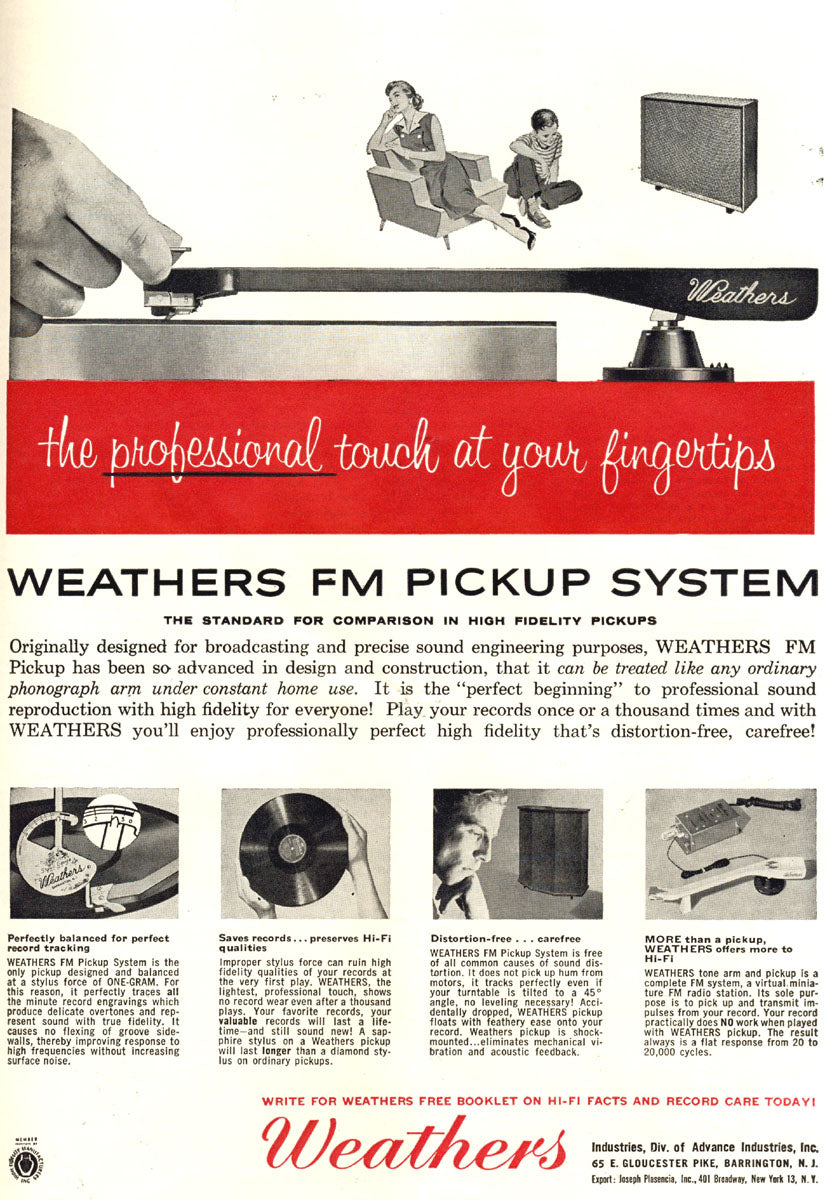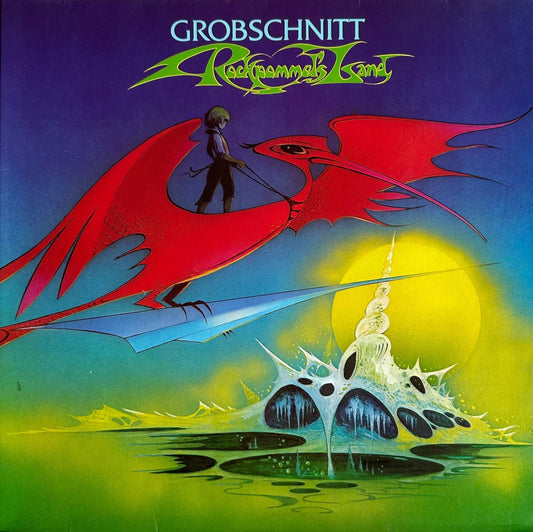In the last issue , we discussed the initial appearance of the Weathers FM phono pickup. In an era of record-chewing cartridges that tracked at 6 grams or more, the Weathers would track at 1 gram. Combined with a viscous-damped tonearm that applied tracking force with a spring (rather than gravity), and protective stylus guards on the base of the cartridge, the Weathers cartridge made it almost impossible to destroy records. Even though vinyl LPs were considerably more break-resistant than brittle 78s, record damage due to heavy tracking weights and mistracking was a significant concern for many users. Common “cures” for mistracking in that era included Scotch-taping a penny or nickel to the tonearm…which of course resulted in increased groove-wear!
The ad below is typical of ’50’s hi-fi ads, which often showed the whole family gathered ’round the speaker (still mono!) to listen to music. It may have been an idealized portrayal: mom was sometimes in an evening gown while dad puffed a pipe and wore a suit…and the kids were always well-behaved. Nonetheless, the family was involved (which is more than we can say about today’s ads!), so gear that would be both indestructible and kind to records was important. —Come to think of it, we might do well to focus on those traits again.
Despite Weathers’ attempts to make “universal” versions of the FM pickup which could be used in other brands of turntables and tonearms, the lightweight cartridge and the light tracking weight posed difficulties. The record changers which then dominated the market generally needed at least 4 grams of downforce to trip the changer mechanism. Paul Weathers focused on a complete package of turntable/arm/cartridge/oscillator which could be plugged into the auxiliary input of a preamp or integrated amp.
Weathers being Weathers, the record player system exhibited very little mainstream thinking. The turntable utilized a stamped aluminum platter that weighed less than most pie-tins. Driving this was a pair of tiny 600-rpm clock motors, one each for 33 1/3 RPM and 45 RPM, which drove the inner platter rim by way of a tiny, spongy rubber drive wheel. The tonearm was simple almost to the point of crudeness, with a slide-holder for the pickup itself, a spring for downforce, and the damping mechanism that would slow the arm, if it were to be dropped.
The turntable’s spindle was a slender 1/8″ shaft with spherical bearing surfaces on both ends, running on thrust plates at both top and bottom. Compared to the spindle and bearing assemblies found in most turntables, the Weathers seemed toy-like; given the platter’s light weight, the assembly was claimed to produce almost immeasurable rumble, and have an indefinite lifespan.
The whole turntable assembly—weighing only 5 pounds or so—was mounted on springs within the base, which Weathers called the “seismic platform”.
Weathers continued to exhibit novel thinking as stereo became more common in the late ’50’s. The company marketed a pair of speakers with each unit the size of hardbound book, indeed made to look like a leatherbound book. Containing a single driver with limited bass extension, the small speakers were designed to couple to an optional common bass speaker, likely the first 2.1 speaker system. What could be more inconspicuous than a bookshelf speaker designed to look like a book? Larger speaker systems arrived as well, like the unit shown in the ad above. Accompanying amplifiers were also sold, but the record players were what the company was known for.
The company’s contrarian approach to product design likely had economic benefits as well. A former Weathers employee wrote years later on the Steve Hoffman Forums, “Mr. Weathers was, as I have posted, a rare combination of excellent engineer and excellent businessman. The tonearm: piece of wood, machine screw and a piece of lead. Worked well, cost next to nothing to build. His factory was just a few miles from [RCA’s headquarters in] Camden, NJ. Most of the speakers we used were surplus stock from RCA. They were treated at the edges with a mixture that I still have the formula for somewhere. Then lead weights were glued to the centers and some were given a large pad of thick cotton, also glued on. He DID know how to make a silk purse out of a sow’s ear! The customers were very happy and loyal. If they had known the cost to retail price ratio, they would have fainted.
“He sold out to TelePrompter… [then the company] went through a couple of other ownerships. He would develop a new line of products, sell a lot, a company would come in and buy him out. Then they would just let it go and come back and ask him if he wanted the company back. He would buy it back, for next to nothing and then introduce new products, that he had been developing all that time. He did that several times. He knew how to make money.”
The FM pickup technology didn’t translate well to the 45/45 stereo format, and while there was an FM stereo model, the company shifted emphasis to a ceramic cartridge which managed to keep most of the benefits of the FM pickup, such as light tracking weight and low overall weight. The company also picked up an employee whose influence would extend far beyond the walls of the factory.
In 1960, a frustrated hi-fi writer went to work for Paul Weathers. In a 1997 Stereophile interview with Steven Stone, J. Gordon Holt told how he came to leave High Fidelity: “I was having constant problems with the publisher, who kept insisting I couldn’t hear the things that I kept reporting that I was hearing. I was a troublemaker. The publisher had to keep riding herd on me to make sure that I didn’t tell the truth about some of this equipment, because on a few occasions the manufacturers had wet their pants when I did.”
Holt found Weathers to be a sympatico personality, and went to work for him: “we went out for dinner. I looked at their equipment and all that kind of thing, and he hired me on the spot…I was their Technical Information Person. I was there for, oh, two years, responsible for writing and distributing technical service bulletins and upgrade notices to dealers. I started putting in some recommended recordings that dealers could use for demonstration purposes. Then we noticed after a while that we were distributing more than three times as many of the things as we had dealers. Seems they were handing them out to their customers. We were distributing something like 300-and-some to about 80 dealers. I figured maybe I was on to something. I decided then that I was going to launch Stereophile. Paul Weathers and I parted amicably, and I started the magazine in 1962.”
The company continued for several years after Holt’s departure, largely rehashing and revising the record player. Oddly enough, NOS units of the later turntables are still available at a surplus company.
The company never regained its spot in the sun, and faded away with the advent of the bigger-better-badder receivers that dominated the late ’60’s. Weathers himself lived until 1992, when he passed away at the age of 86. Nearly 60 years after the Weathers company’s heyday, many still regard it as a shining example of innovation and creativity…and ex-employee Holt’s magazine is still around, 54 years later!
Special thanks to John Atkinson, Editor of Stereophile, for assistance with the JGH chapter of the Weathers story.





